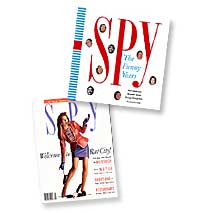
W hen you hear magazine people talk about magazines, they say special things about Spy. Editors and writers as well as readers—especially those who were young and in New York from 1986 through the early nineties, when the magazine was at its best—still speak wistfully about Spy’s perfectly balanced, perfectly piquant cocktail of irony, brains, silliness, visual pizzazz, and reportorial ferocity, all packed into painfully small type. Even the tiny standing features and inimitable-yet-widely-imitated charts were tuned to a particular rarefied frequency, and the new twentieth-anniversary collection–cum–history Spy: The Funny Years is an excellent reminder of just how craftsmanlike it was.
It was also an extraordinary place to work, characterized by near-cultish fervor for the environment created by founding editors E. Graydon Carter (who, having lost his E., now runs Vanity Fair) and Kurt Andersen (New York columnist, public-radio host, and novelist). The staff, represented here by co-author and alumnus George Kalogerakis, embraced their badly paid work with a zeal that recurred, except with a profit motive, at the baby dot-coms of a decade later. You can see the love, dysfunctional and functional alike, in the book’s reprinted office detritus: memos, tales of office high jinks, uncommonly clever doodles. In fact, the authors suggest that Spy could almost be mistaken for a late-nineties new-media start-up, marked by high enthusiasm, a mania for hard numbers, a refined grasp of the medium, and an ultimately dodgy business plan. The sense that it all could end at any moment turns out to be one reason for all that tiny type. Andersen admits that the editors often jammed as many stories as possible into their lineup, fearing that there might not be a next issue.
By Kurt Andersen, Graydon Carter, and George Kalogerakis; Melcher Media; $39.95